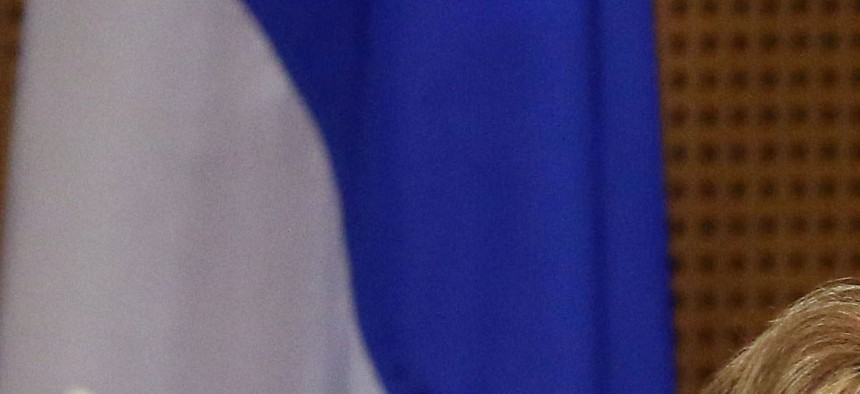
EU foreign policy chief Catherine Ashton and Iranian foreign minister Javad Zarif during a set of meetings in Austria Ronald Zak/AP
A Formula for Success with Iran
As P5+1 talks resume Tuesday in Vienna, U.S. officials and experts are already expecting a nuclear deal by this summer. Here’s how. By Joseph Cirincione
This week, negotiators from six world powers will meet again with Iran for what have become near-constant meetings on Iran’s nuclear program. Enough progress has been made by the group (the United States, United Kingdom, France, Russia, China and Germany) that U.S. officials announced they would begin in May to draft the final agreement.
Prospects for a deal this summer are rising, with official pronouncements now being matched by outside expert assessments. “We actually think that negations are serious enough to warrant discussion about a potential deal, the implications and, most importantly, thinking ahead,” RAND Director of the Center for Middle East Public Policy Dalia Dass Kaye told a high-level conference convened in Washington last week to explore “the days after a nuclear deal.”
Among us, the list of what’s required for a deal with Iran has moved dramatically from unrealistic demands that Iran dismantle its entire nuclear infrastructure to outlines of arrangements that could verifiably limit Iran’s nuclear program to purely peaceful use. As retired Israeli Defense Forces Brig. Gen. Shlomo Brom told a conference in Israel last week, “Anyone that thinks that a deal, even a good deal, can be concluded without letting Iran have some capabilities for enriching uranium and producing nuclear fuel…is deluding themselves.”
Such a deal will likely not be based on some magic number of allowed centrifuges or kilos of uranium. But there is a formula that could guide negotiators to a solution that all the parties could support.
Skeptics need confidence. The key is not to focus on one or two capabilities, but to see the problem in its entirety. Balancing limits on capabilities with increased transparency and assured penalties for violations could give nations confidence that Iran’s program was so confined, monitored and understood that it could not quickly or secretly turn to producing a nuclear weapon.
While the talks are complex, the basic facts are well understood and can be broken down into ten key issues. Confidence could be viewed as a function of the relative value of these various issues. The equation could be express as follows:
C = f (QC + CC + LC + QLEU + Pu + R&D + V + HPMD + D + PW)
Translated, this means that confidence (C) is a function of the balance of ten core factors:
- Quantity of centrifuges (QC). The more centrifuges Iran has, the more quickly it could produce highly-enriched uranium for bombs.
- Capability of centrifuges (CC). The more advanced Iran’s machines are, the more quickly they can enrich uranium to bomb quality.
- Locations of centrifuges (LC). Having the machinery located at just one site at Natanz helps verification and makes the program more susceptible to military strikes, should Iran break the deal.
- Quantity of low-enriched uranium (QLEU). The more low-enriched uranium that Iran stockpiles, the more quickly it could convert it to bomb-grade, particularly if some of the LEU was already enriched to fairly high levels.
- Plutonium production capabilities (Pu). Since plutonium can also be used to make weapons, Iran will have to limit any facility such as the Arak reactor under construction, which can produce this material.
- Research and development on advanced technologies (R&D). If Iran develops more advanced centrifuges or works on technologies that could be used for weapons, this would undermine confidence in the deal.
- Verification of all of Iran’s activities (V). The more tightly that facilities are monitored, the more confident inspectors will be in the ability to detect quickly any effort to break out and sprint to a bomb.
- Disclosure of the history of programs with possible military dimensions (HPMD). Iran will have to answer questions about its past programs that may have involved work on nuclear weapon technologies in order for nations to have confidence in its future intentions.
- The duration of the deal (D). There will have to be agreement on how long the restrictions will last, either as a whole or separately.
- The political willingness of the parties to enforce the deal (PW). Ultimately, the deal will rest on the belief that nations will react quickly and certainly to any violations of the agreement.
The trick will be to balance this equation by adjusting the value of the variables. Nations might be willing to agree to Iran operating a larger number of centrifuges, for example, if they were confined to one location, there were strict limits on the stockpiles of uranium gas going into the centrifuges and monitoring arrangements were so transparent as to assure with high confidence that any use of the machines to make bomb material would be quickly detected and stopped.
It is unlikely that by July 20, the negotiations will produce a clear history of Iran’s past suspect activities. Talks on one of these issues (research into so-called bridge wire detonators that could be used for weapons) is proceeding well, but the full exchange of information will not take place until May. Negotiators may have to develop a procedure for resolving all these past issues, rather that the complete Iranian confession that some skeptics want before any deal is finalized with Tehran.
All of this will have to be matched by a plan for the phased reduction and eventual elimination of sanctions. This should be an “action-for-action” deal, where successful performance by Iran is met with successful sanction relief by the other states.
Successfully balancing this equation could lead to a deal that does not eliminate Iran’s capabilities but would be a deal “designed to prevent Iran from having a rapid breakout capability and to deter a future Iranian decision to build nuclear weapons,” says former Iranian negotiator Robert Einhorn in a new report from the Brookings Institution.
All parties are committed to reaching a comprehensive agreement by the declared deadline of July 20. Officials from the negotiating states believe that they can meet that goal, but the bargaining will be tough. It will likely go down to the wire, and perhaps require some time extensions. Having a formula for success could help the negotiators keep their eyes on the prize in the turbulent weeks ahead.
Joe Cirincione is president of Ploughshares Fund, author of Nuclear Nightmares: Securing the World before It Is Too Late. He serves on the International Security Advisory Board to the Secretary of State but the views expressed are his alone and do not represent the views of the Department of State or the U.S. government.




